A B-Polynomial Approach to Approximate Solutions of PDEs with Multiple Initial Conditions
Abstract
:1. Introduction
2. Methodology
- Integration and Condition Incorporation: The first step involves systematically integrating the linear PDE while accommodating all specified initial and boundary conditions. This integration is crucial as it reformulates the problem, allowing the conditions to be incorporated into the structure of the equation, thus ensuring that the solutions adhere to these constraints.
- Approximation via B-Polynomials: The second step entails expressing the approximate solution using B-polynomials. B-polynomials are particularly advantageous due to their properties of preservation under linear transformations and their ability to provide good approximations for smooth functions. We formulate the approximate solution as a linear combination of B-polynomials, where the unknown coefficients are then determined using the Galerkin finite element method (FEM). This method involves projecting the PDE onto a finite-dimensional space spanned by the B-polynomials, leading to a system of algebraic equations that can be solved efficiently using modern computers. The Bernstein basis polynomials of degree n are defined as follows [46]:where denotes the binomial coefficient:
- 3.
- We consider the following equation as a typical partial differential equation [48].
3. Application
4. Results
5. Implications
6. Conclusions
Author Contributions
Funding
Data Availability Statement
Acknowledgments
Conflicts of Interest
References
- Sommerfeld, A. Partial Differential Equations in Physics. 1949. Available online: https://books.google.com/books?hl=en&lr=&id=PFsDVARE4C0C&oi=fnd&pg=PP1&dq=partial+differential+equations+in+physics&ots=I7LpXtnCrq&sig=t5Sq4nDcIZxgIc5ojuelGWpz45k (accessed on 7 September 2024).
- MSimpson, J.; McCue, S.W. Fisher-KPP-type models of biological invasion: Open source computational tools, key concepts and analysis. arXiv 2014, arXiv:2403.01667. [Google Scholar]
- Li, W.; Carvalho, R. Automating the Discovery of Partial Differential Equations in Dynamical Systems. arXiv 2024, arXiv:2404.16444v1. [Google Scholar] [CrossRef]
- Raissi, M. Forward-Backward Stochastic Neural Networks: Deep Learning of High-Dimensional Partial Differential Equations. In Peter Carr Gedenkschrift: Research Advances in Mathematical Finance; World Scientific: Singapore, 2023; pp. 637–655. [Google Scholar] [CrossRef]
- Farlow, S. Partial Differential Equations for Scientists and Engineers. 2012. Available online: https://books.google.com/books?hl=en&lr=&id=VsK_31_j0XgC&oi=fnd&pg=PP1&dq=partial+differential+equations+in+engineering&ots=beSEp3W8NO&sig=SGiZBACjiKXDBcq-8gmjJD5LY7s (accessed on 7 September 2024).
- Mahmudov, E.N.; Mastaliyeva, D. Optimal control of second order hereditary functional-differential inclusions with state constraints. J. Ind. Manag. Optim. 2024, 20, 3562–3579. [Google Scholar] [CrossRef]
- Byrne, H.M.; Harrington, H.A.; Ovchinnikov, A.; Pogudin, G.; Rahkooy, H.; Soto, P. Algebraic identifiability of partial differential equation models. arXiv 2024, arXiv:2402.04241. [Google Scholar]
- Bao, T.; Du, H.; Xiang, W.; Johnson, T.T. A New Hybrid Automaton Framework with Partial Differential Equation Dynamics. arXiv 2024, arXiv:2404.11900. [Google Scholar]
- Gao, H.; Kaltenbach, S.; Koumoutsakos, P. Generative Learning of the Solution of Parametric Partial Differential Equations Using Guided Diffusion Models and Virtual Observations. arXiv 2024, arXiv:2408.00157. [Google Scholar]
- Krivorotko, O.; Kabanikhin, S. Artificial intelligence for COVID-19 spread modeling. J. Inverse Ill. Posed Probl. 2024, 32, 297–332. [Google Scholar] [CrossRef]
- Gao, X.; Xu, Y. Markovian Approach for Exploring Competitive Diseases with Heterogeneity-Evidence from COVID-19 and Influenza in China. Bull. Math. Biol. 2024, 86, 71. [Google Scholar] [CrossRef]
- Esmaili, S.; Eslahchi, M.R.; Torres, D.F. Optimization, and undefined 2024 Optimal control for a nonlinear stochastic PDE model of cancer growth. Optimization 2023, 73, 2745–2789. [Google Scholar] [CrossRef]
- Salas, A.H.; El-Tantawy, S.A.; Jairo E, C.H. On the approximate and analytical solutions to the fifth-order Duffing oscillator and its physical applications. Waves Random Complex Media 2021, 34, 2000–2020. [Google Scholar] [CrossRef]
- Yıldız, M. Science and undefined 2024 Solution scheme development of the nonhomogeneous heat conduction equation in cylindrical coordinates with neumann boundary condition by finite difference. Eur. Mech. Sci. 2024, 8, 179–190. [Google Scholar] [CrossRef]
- Benmebarek, F.; Alloui, L.; Benmebarek, F.; Gabi, Y.; Mimoune, S.M.; Wolter, B. Three-Dimensional Numerical Modelling of Eddy Current System Using the Finite Volume Method. Prz. Elektrotechniczny 2024, 2024. [Google Scholar] [CrossRef]
- Yoneyama, S.; Arikawa, S.; Kobayashi, Y. Linear and Nonlinear Algorithms for Stress Separation in Photoelasticity. Exp. Mech. 2012, 52, 529–538. [Google Scholar] [CrossRef]
- Liu, Q.; Ma, J. Foundation Models for Geophysics: Reviews and Perspectives. arXiv 2024, arXiv:2406.03163. [Google Scholar]
- Zhao, T.; Sun, C.; Cohen, A.; Stokes, J.; Veerapaneni, S. Quantum-inspired variational algorithms for partial differential equations: Application to financial derivative pricing. Quant. Financ. 2023, 24, 1–11. [Google Scholar] [CrossRef]
- Moreno, S.R.; Seman, L.O.; Stefenon, S.F.; dos Santos Coelho, L.; Mariani, V.C. Enhancing wind speed forecasting through synergy of machine learning, singular spectral analysis, and variational mode decomposition. Energy 2024, 292, 130493. [Google Scholar] [CrossRef]
- Koriko, O.K.; Adegbie, K.S.; Shah, N.A.; Animasaun, I.L.; Olotu, M.A. Numerical solutions of the partial differential equations for investigating the significance of partial slip due to lateral velocity and viscous dissipation: The case of blood-gold Carreau nanofluid and dusty fluid. Numer. Methods Partial. Differ. Equ. 2024, 40, e22754. [Google Scholar] [CrossRef]
- Johnson, J.T.; Madadi, M.; Ladiges, D.R.; Shi, Y.; Hughes, B.D.; Sader, J.E. Variational solution to the lattice Boltzmann method for Couette flow. Phys. Rev. E 2024, 109, 055305. [Google Scholar] [CrossRef]
- Banerjee, P.; Murthy, V.; Jain, S. Variational Quantum Crank-Nicolson and Method of Lines for the Solution of Initial Value Problems. arXiv 2024, arXiv:2404.07016. [Google Scholar]
- Caballero, F. cuPSS: A Package for Pseudo-Spectral Integration of Stochastic PDEs. Available online: http://github.com/fcaballerop/cuPSS (accessed on 10 September 2024).
- Bhatti, M.I.; Bhatta, D.D. Numerical solutions of Burgers’ equation in a B-polynomial basis. Phys. Scr. 2024, 73, 539. [Google Scholar] [CrossRef]
- Shen, S.W.; Tsai, C.W. Incorporating memory effect into a fractional stochastic diffusion particle tracking model for suspended sediment using Malliavin-Calculus-based fractional Brownian Motion. Chaos Solitons Fractals 2024, 187, 115312. [Google Scholar] [CrossRef]
- Gao, X.Y.; Guo, Y.J.; Shan, W.R. On the Oceanic/Laky Shallow-Water Dynamics through a Boussinesq-Burgers System. Qual. Theory Dyn. Syst. 2024, 23, 57. [Google Scholar] [CrossRef]
- Pinto, H.L.; Oliveira, T.R.; Rodrigues, V.H.P.; Hsu, L.; Krstic, M. Sliding mode control for disturbance rejection and estimation under measurement delay with PDE-backstepping predictor. Int. J. Robust Nonlinear Control. 2024, 34, 2865–2886. [Google Scholar] [CrossRef]
- Ye, J.; Shen, C.; Peserico, N.; Meng, J.; Ma, X.; Nouri, B.M.; Popescu, C.C.; Hu, J.; Kang, H.; Wang, H.; et al. Reconfigurable application-specific photonic integrated circuit for solving partial differential equations. Nanophotonics 2024, 13, 2231–2239. [Google Scholar] [CrossRef]
- Prakasa Rao, B.L.S. Series and Undefined 2001 Statistical Inference for Stochastic Partial Differential Equations. JSTOR. Available online: https://www.jstor.org/stable/4356143 (accessed on 9 September 2024).
- Dehghan, M.; Heris, J.M.; Saadatmandi, A. Application of the Exp-function method for solving a partial differential equation arising in biology and population genetics. Int. J. Numer. Methods Heat Fluid Flow 2011, 21, 736–753. [Google Scholar] [CrossRef]
- Yu, Z.; Wu, L.; Zhou, Z.; Zhao, S. Papers, and undefined 2024 A Differential Monte Carlo Solver for the Poisson Equation. In Proceedings of the ACM SIGGRAPH 2024 Conference Papers, Denver, CO, USA, 27 July–1 August 2024; pp. 1–10. [Google Scholar] [CrossRef]
- Yin, P.; Ling, S.; Ying, W. Chebyshev Spectral Neural Networks for Solving Partial Differential Equations. arXiv 2024, arXiv:2407.03347. [Google Scholar]
- Lagergren, J.H.; Nardini, J.T.; Michael Lavigne, G.; Rutter, E.M.; Flores, K.B. Learning partial differential equations for biological transport models from noisy spatio-temporal data. Proc. R. Soc. A 2020, 476, 2234. Available online: https://royalsocietypublishing.org/doi/abs/10.1098/rspa.2019.0800 (accessed on 9 September 2024). [CrossRef]
- Bhatti, M.I.; Hinojosa, E. Results of hyperbolic partial differential equations in B-poly basis. J. Phys. Commun. 2020, 4, 095010. [Google Scholar] [CrossRef]
- MacNeal, R. The Solution of Partial Differential Equations by Means of Electrical Networks. 1949. Available online: https://thesis.library.caltech.edu/1529/ (accessed on 9 September 2024).
- Li, Z.; Zheng, H.; Kovachki, N.; Jin, D.; Chen, H.; Liu, B.; Azizzadenesheli, K.; Anandkumar, A. Physics-informed neural operator for learning partial differential equations. ACM/JMS J. Data Sci. 2024, 1, 1–27. [Google Scholar] [CrossRef]
- Ngondiep, E. A Fast Third-Step Second-Order Explicit Numerical Approach to Investigating and Forecasting the Dynamic of Corruption and Poverty in Cameroon. arXiv 2022, arXiv:2206.05022. [Google Scholar]
- Mamo, D.K.; Ayele, E.A.; Teklu, S.W. Modelling and Analysis of the Impact of Corruption on Economic Growth and Unemployment. Oper. Res. Forum 2024, 5, 36. [Google Scholar] [CrossRef]
- Marrero, G.A.; Servén, L. Growth, inequality and poverty: A robust relationship? Empir. Econ. 2022, 63, 725–791. [Google Scholar] [CrossRef] [PubMed]
- Leung, A. Nonlinear Systems of Partial Differential Equations: Applications to Life and Physical Sciences. 2009. Available online: https://books.google.com/books?hl=en&lr=&id=kdjFCgAAQBAJ&oi=fnd&pg=PR7&dq=partial+differential+equations+in+nonlinear+systems&ots=rLL7gksmAC&sig=v_6Hetf970hnBVJHEKBpAG_WlTI (accessed on 9 September 2024).
- Qiao, N.; Zou, B. Nonlocal orientation diffusion partial differential equation model for optics image denoising. Optik 2013, 124, 1889–1891. [Google Scholar] [CrossRef]
- Rauch, J. Hyperbolic Partial Differential Equations and Geometric Optics. 2012. Available online: https://books.google.com/books?hl=en&lr=&id=Q1yDAwAAQBAJ&oi=fnd&pg=PR11&dq=partial+differential+equations+in+optics&ots=gsQbSM2bQE&sig=ryibXVveDJwXV_vOg_7nhc4VU2U (accessed on 9 September 2024).
- Al-Smadi, M.; Arqub, O.A.; Hadid, S. An attractive analytical technique for coupled system of fractional partial differential equations in shallow water waves with conformable derivative. Commun. Theor. Phys. 2020, 72, 085001. Available online: https://iopscience.iop.org/article/10.1088/1572-9494/ab8a29/meta (accessed on 9 September 2024). [CrossRef]
- Holmes, P.; Marsden, J. A partial differential equation with infinitely many periodic orbits: Chaotic oscillations of a forced beam. Arch. Ration. Mech. Anal. 1981, 76, 135–165. [Google Scholar] [CrossRef]
- Bhatti, M.I.; Rahman, M.H. Technique to Solve Linear Fractional Differential Equations Using B-Polynomials Bases. Fractal Fract. 2021, 5, 208. [Google Scholar] [CrossRef]
- Bhatti, M.I.; Bracken, P. Solutions of differential equations in a Bernstein polynomial basis. J. Comput. Appl. Math. 2007, 205, 272–280. [Google Scholar] [CrossRef]
- Bhatti, M.I.; Rahman, M.H.; Dimakis, N. Approximate Solutions of Nonlinear Partial Differential Equations Using B-Polynomial Bases. Fractal Fract. 2021, 5, 106. [Google Scholar] [CrossRef]
- Al-Mazmumy, M.; Alsulami, M. Utilization of the Modified Adomian Decomposition Method on the Bagley-Torvik Equation Amidst Dirichlet Boundary Conditions. Eur. J. Pure Appl. Math. 2024, 17, 546–568. [Google Scholar] [CrossRef]
- Wolfram Research, Inc. Mathematica, version 14.1; Wolfram Research, Inc.: Champaign, IL, USA, 2024.
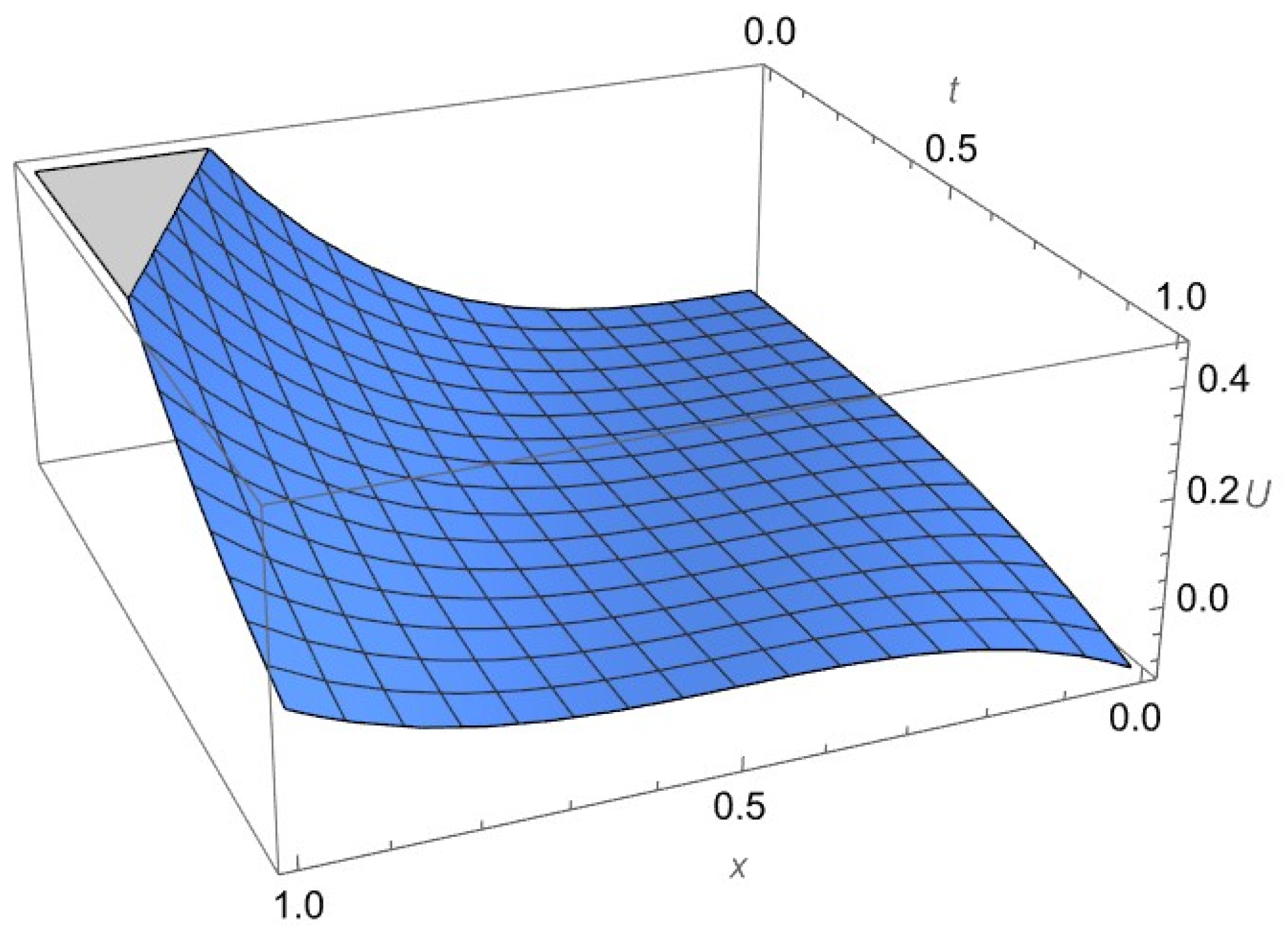
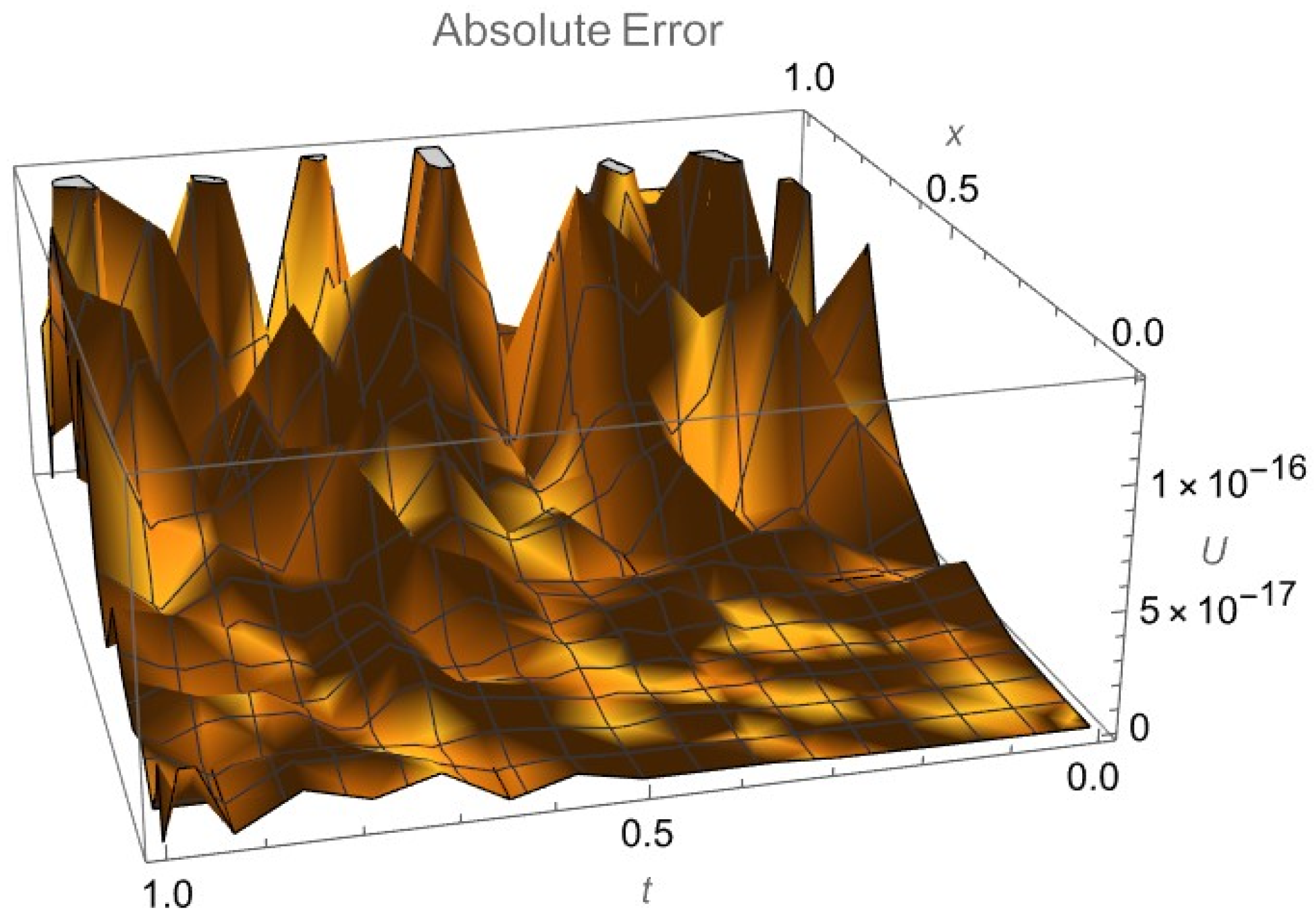


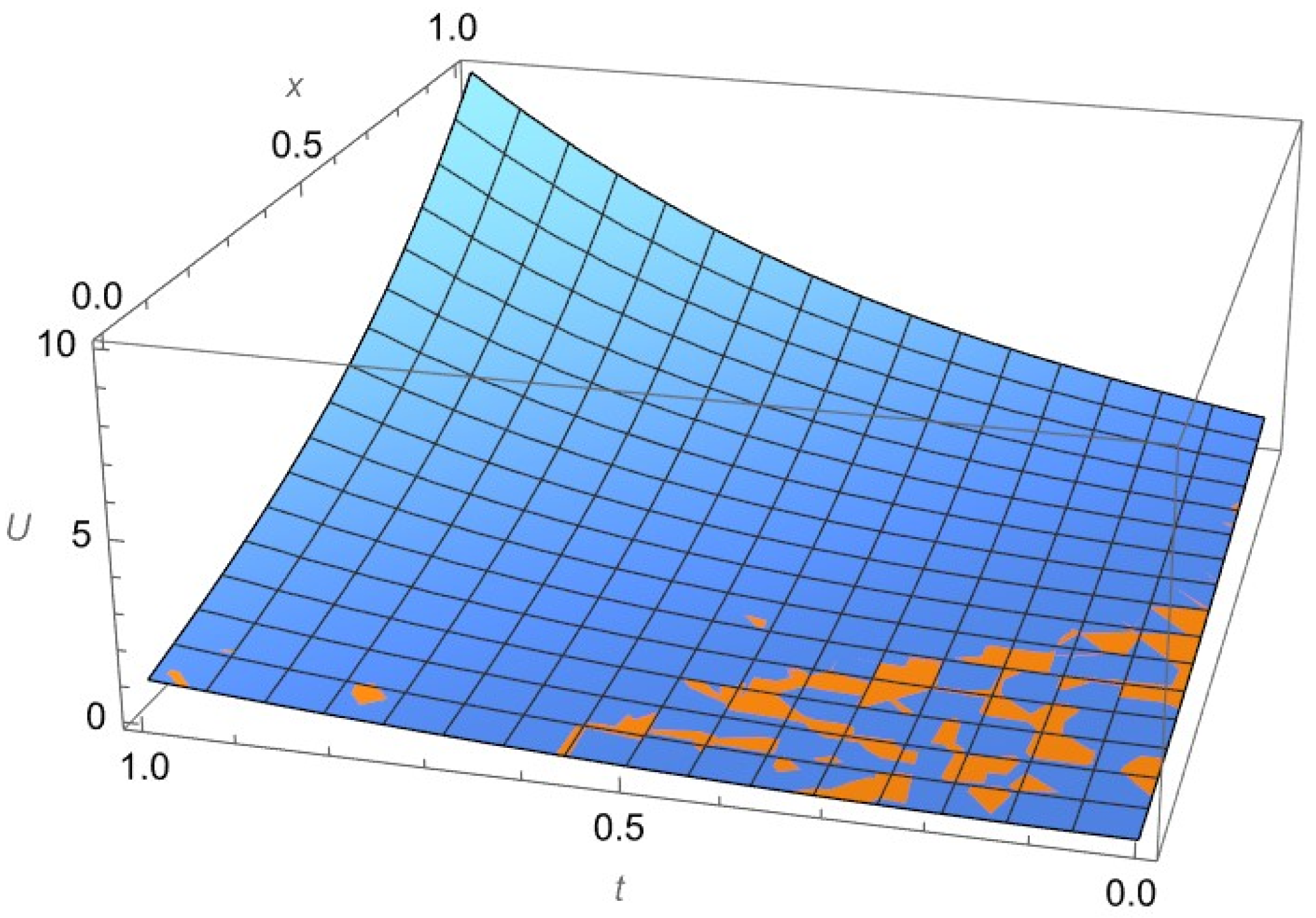

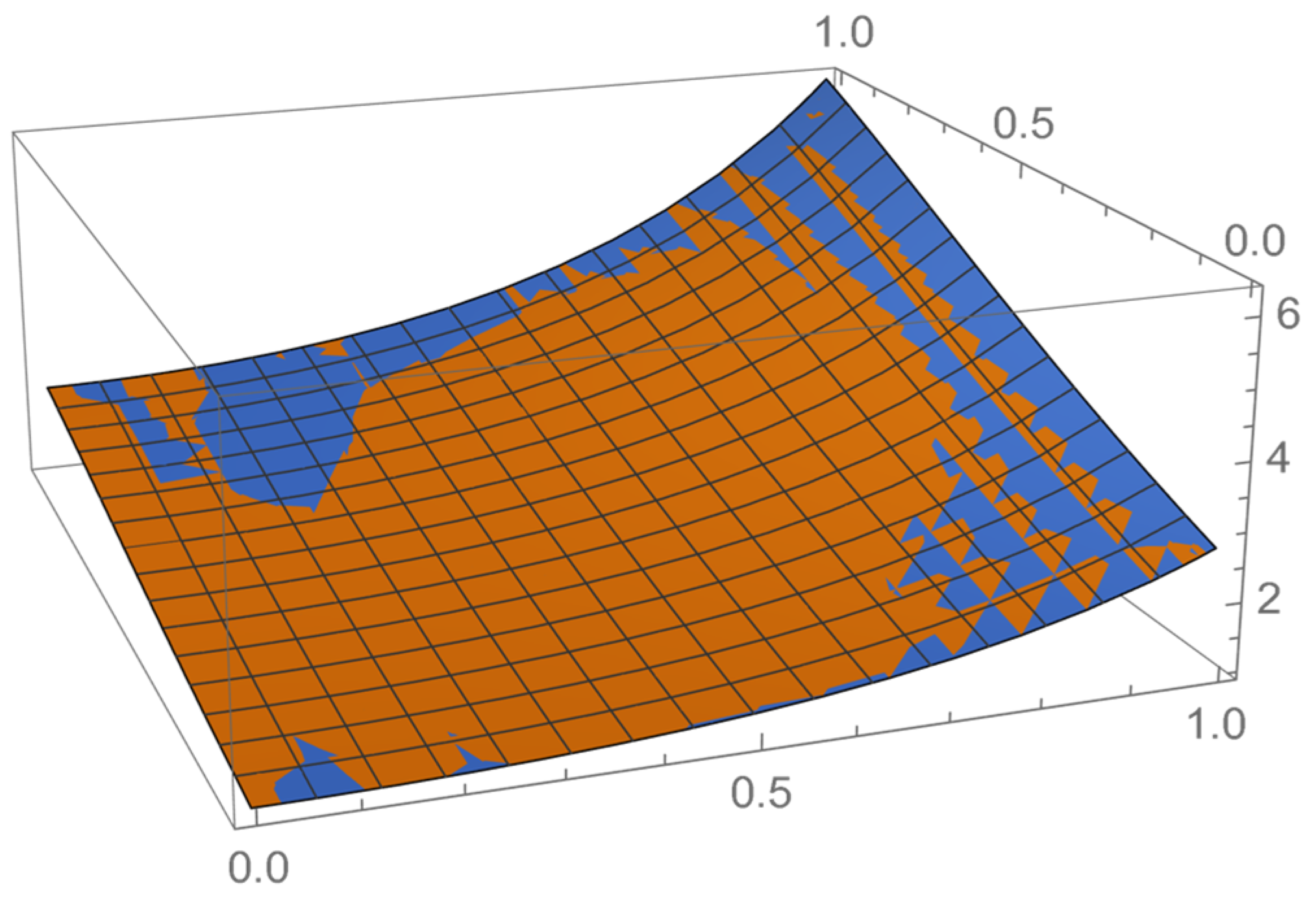
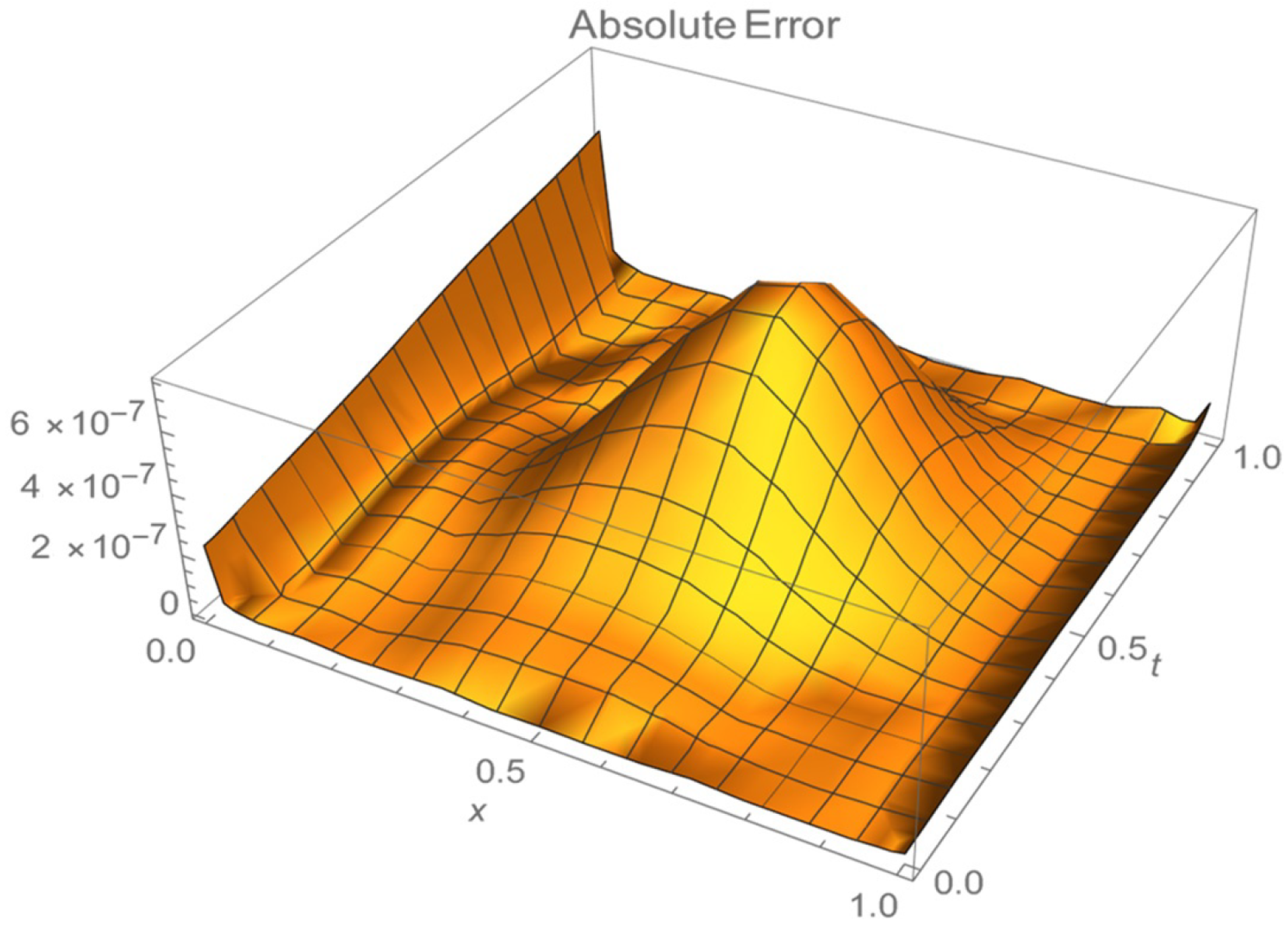

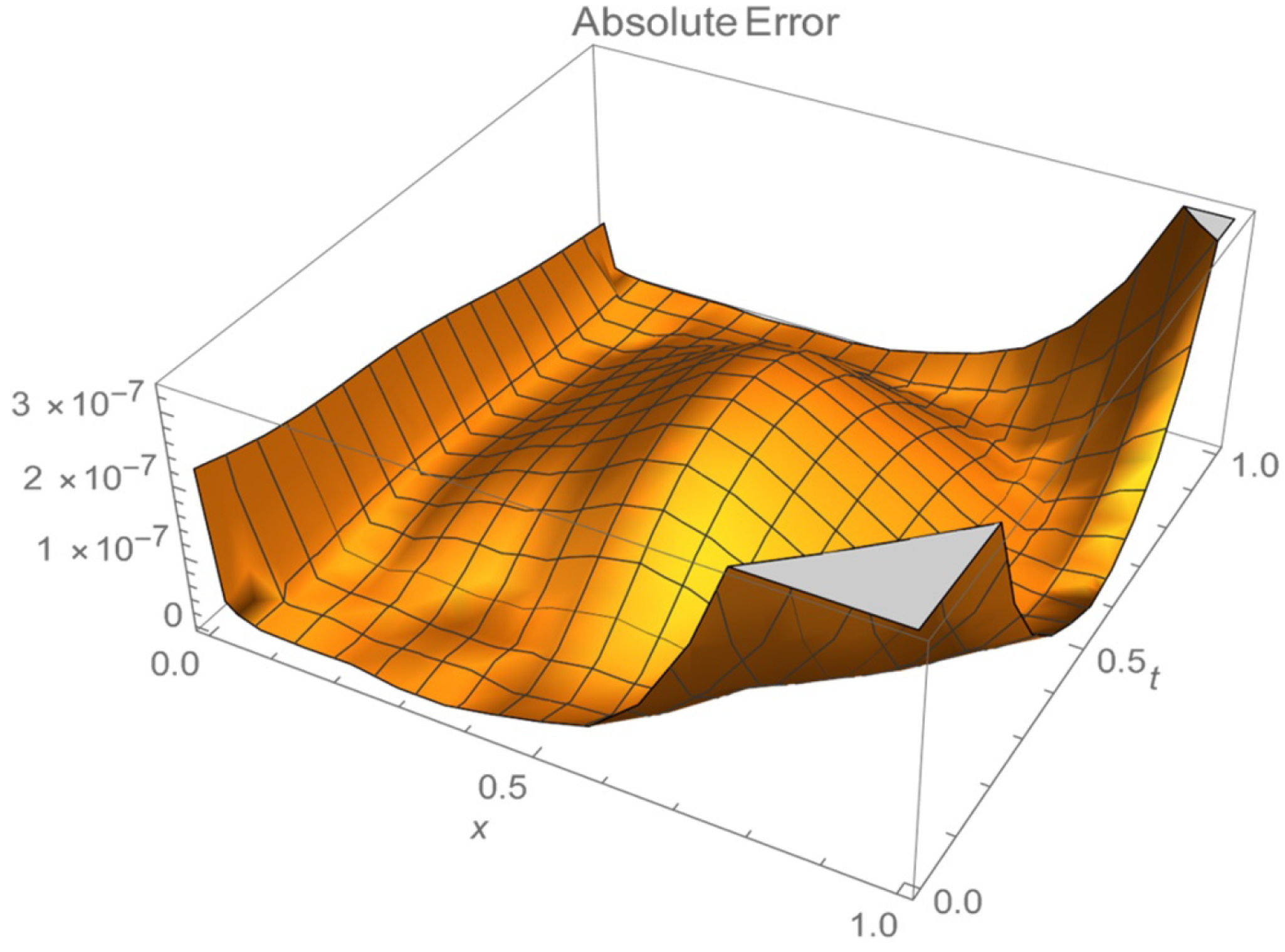
| Value of x | Value of t | Approximate Value of U (x, t) Using Current Method | Exact Value of U (x, t) |
|---|---|---|---|
| 0 | −0.015625 | ||
| 0.5 | −0.000125 | ||
| 0.003375 | |||
| 0.421875 | |||
| 0.166375 | |||
| 1 | 0.421875 |
| Value of x | Value of t | Approximate Value of U (x, t) Using Current Method | Exact Value of U (x, t) |
|---|---|---|---|
| 0 | 1 | ||
| 1 | |||
| 1 | |||
| 1 | |||
| 1 | |||
| 1 | 1 |
| Value of x | Value of t | Approximate Value of U (x, t) Using Current Method | Exact Value of U (x, t) |
|---|---|---|---|
| 0 | |||
| 0.5 | |||
| 1 |
| Value of x | Value of t | Approximate Value of U (x, t) Using Current Method | Exact Value of U (x, t) |
|---|---|---|---|
| 0 | 1 | ||
| 1 | |||
| 1 | |||
| 1 | |||
| 1 | |||
| 1 | 1 |
| Value of x | Value of t | Approximate Value of U (x, t) Using Current Method | Exact Value of U (x, t) |
|---|---|---|---|
| 0 | |||
| 0.5 | |||
| 1 |
| Value of x | Value of t | Approximate Value of U (x, t) Using Current Method | Exact Value of U (x, t) |
|---|---|---|---|
| 0 | 1 | ||
| 1 | |||
| 1 | |||
| 1 | |||
| 1 | |||
| 1 | 1 |
| Value of x | Value of t | Approximate Value of U (x, t) Using Current Method | Exact Value of U (x, t) |
|---|---|---|---|
| 0 | |||
| 0.5 | |||
| 1 |
| Value of x | Value of t | Approximate Value of U (x, t) Using Current Method | Exact Value of U (x, t) |
|---|---|---|---|
| 0 | 1 | ||
| 1 | |||
| 1 | |||
| 1 | |||
| 1 | |||
| 1 | 1 |
| Value of x | Value of t | Approximate Value of U (x, t) Using Current Method | Exact Value of U (x, t) |
|---|---|---|---|
| 0 | 0.5 | 0.606531 | 0.606531 |
| 0.5 | 0.631284 | 0.631284 | |
| 0.5 | 0.711770 | 0.711770 | |
| 0.5 | 0.869358 | 0.869358 | |
| 0.5 | 1.150274 | 1.150274 | |
| 1 | 0.5 | 1.648721 | 1.648721 |
| Value of x | Value of t | Approximate Value of U (x, t) Using Current Method | Exact Value of U (x, t) |
|---|---|---|---|
| 0 | 1 | 0.367879 | 0.367879 |
| 1 | 0.382893 | 0.382893 | |
| 1 | 0.431711 | 0.431711 | |
| 1 | 0.527292 | 0.527292 | |
| 1 | 0.697676 | 0.697676 | |
| 1 | 1 | 1.000000 | 1.000000 |
Disclaimer/Publisher’s Note: The statements, opinions and data contained in all publications are solely those of the individual author(s) and contributor(s) and not of MDPI and/or the editor(s). MDPI and/or the editor(s) disclaim responsibility for any injury to people or property resulting from any ideas, methods, instructions or products referred to in the content. |
© 2024 by the authors. Licensee MDPI, Basel, Switzerland. This article is an open access article distributed under the terms and conditions of the Creative Commons Attribution (CC BY) license (https://creativecommons.org/licenses/by/4.0/).
Share and Cite
Bhatti, M.I.; Rahman, M.H. A B-Polynomial Approach to Approximate Solutions of PDEs with Multiple Initial Conditions. Axioms 2024, 13, 833. https://doi.org/10.3390/axioms13120833
Bhatti MI, Rahman MH. A B-Polynomial Approach to Approximate Solutions of PDEs with Multiple Initial Conditions. Axioms. 2024; 13(12):833. https://doi.org/10.3390/axioms13120833
Chicago/Turabian StyleBhatti, Muhammad I., and Md. Habibur Rahman. 2024. "A B-Polynomial Approach to Approximate Solutions of PDEs with Multiple Initial Conditions" Axioms 13, no. 12: 833. https://doi.org/10.3390/axioms13120833
APA StyleBhatti, M. I., & Rahman, M. H. (2024). A B-Polynomial Approach to Approximate Solutions of PDEs with Multiple Initial Conditions. Axioms, 13(12), 833. https://doi.org/10.3390/axioms13120833







